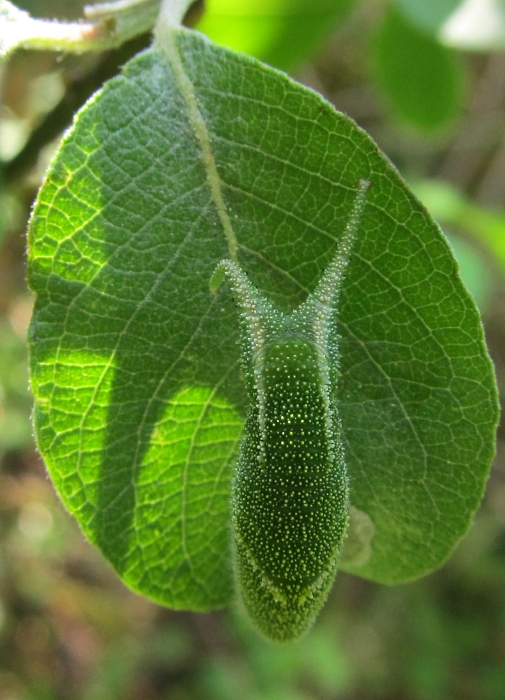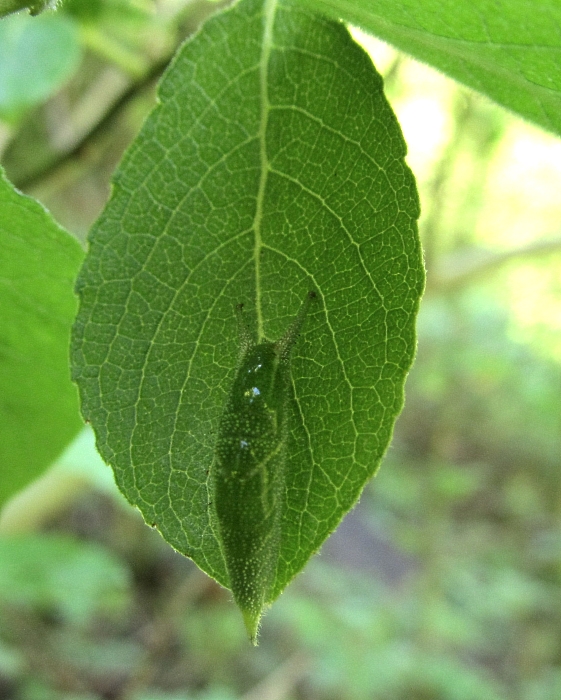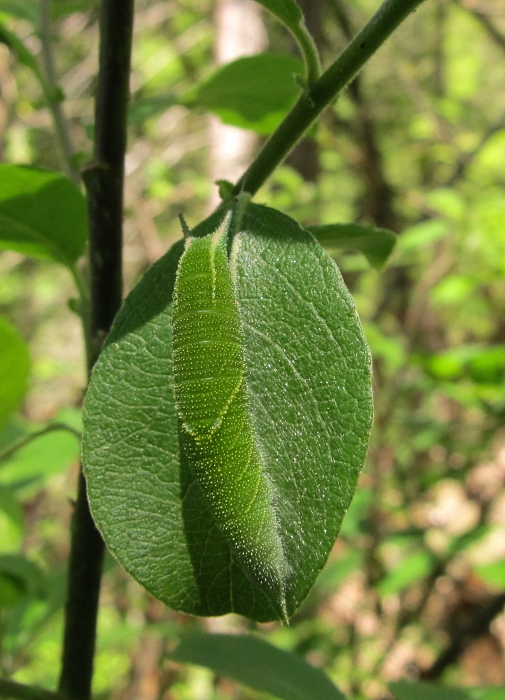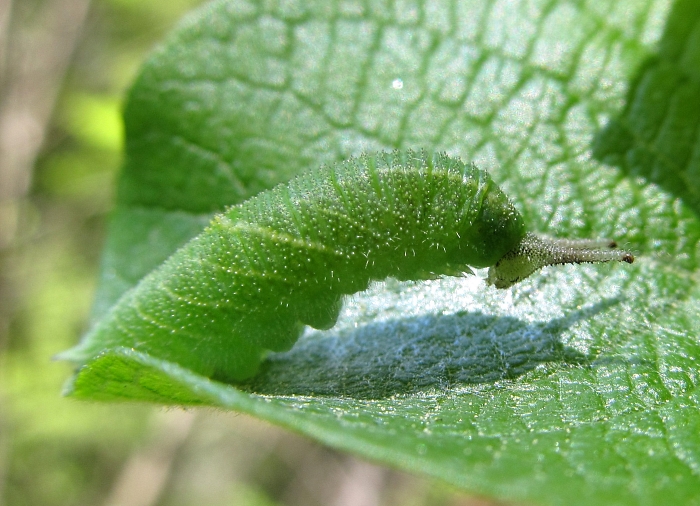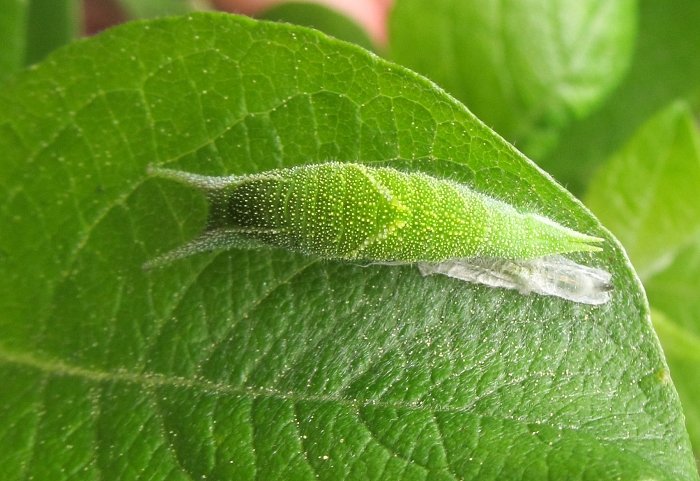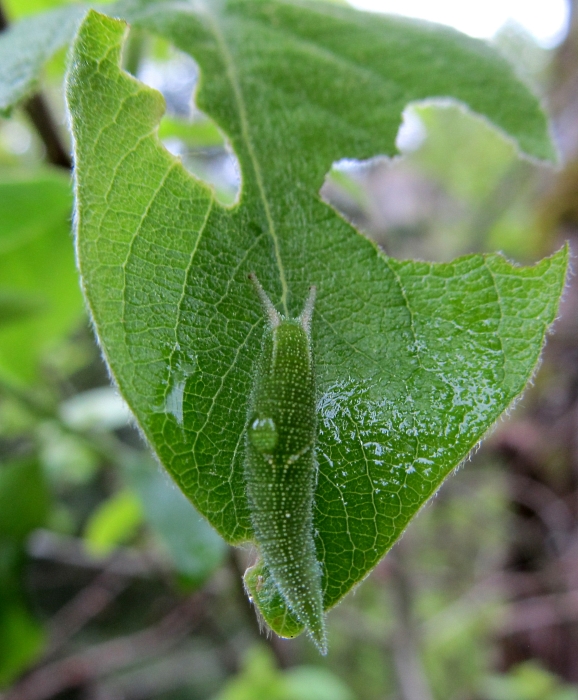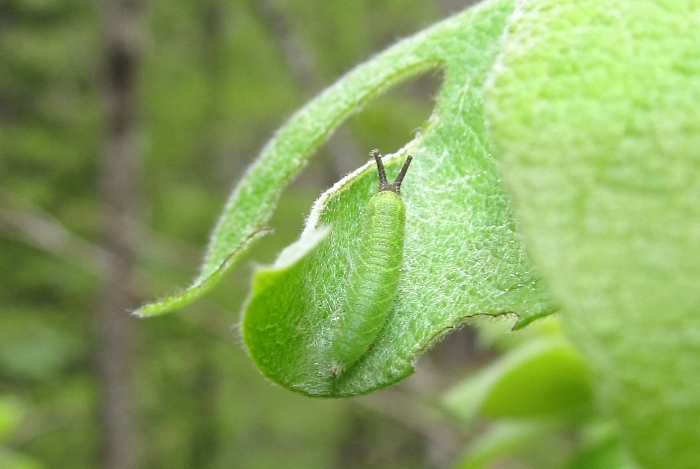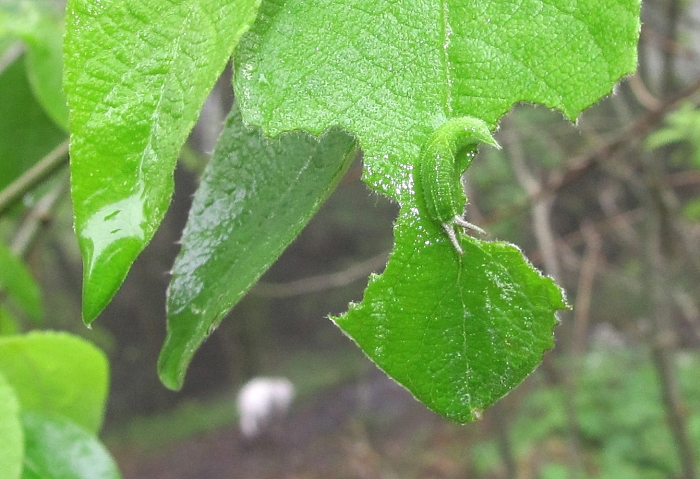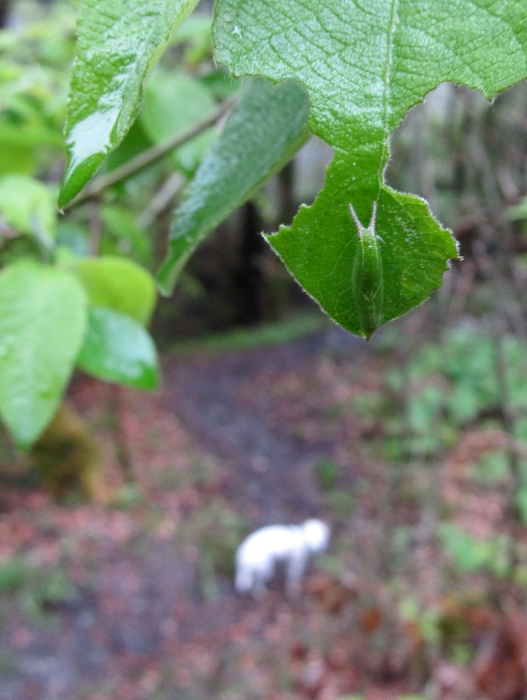The last week of May is one of the key weeks in the butterflying calendar, only this time the weather's been foul. Purple Emperor larvae have scarcely grown since my last post - which is perhaps a good thing as they were ridiculously advanced and actually needed slowing down. A visit to the Savernake area on Sat May 24th found that most of the few surviving larvae were 2-4 days off from pupating, like this one -
However, there is one runt, who was only just changing into the 4th instar. This larva was on a tree that was felled during the winter. It wasn't dislodged when the tree crashed down. I left it to see how it fared, but then moved it on April 21st when it became clear that the tree wasn't going to come into leaf. So I pet rescued the poor fellow, whilst it was still in hibernation (late), and placed it on a nearby young sallow. I think it only commenced feeding at the end of April. Here it is, skin changing to the 4th instar -
My prediction now is that iris will start to emerge around June 20th, but much depends on June weather as the insect spends ages in the pupal stage if the weather's poor.
I am not optimistic about adult numbers this year, having recorded record levels of predation this winter (from a sample of 63 larvae) and having had a surprisingly high number of larvae vanish during April and May too. Much depends on June weather and, especially on flight season weather, but I fear that iris will be relatively scarce this year. Hopefully I have got this terribly wrong, in which case I will post a selfie of me eating my hat...
Thursday, May 29, 2014
Saturday, May 24, 2014
Rounding the horn
One of my wild cats (Novus) emerged into 5th instar yesterday with a decurved horn. It was still decurved today, so obviously not snagged or anything:
I trust the horns are purely decorative and this will make no difference.
My youngest (Sextus) turned 4th instar yesterday. I didn't find him early enough in the year to know if he is one of those few that hibernate in 2nd instar.
5m away, on a 2m sapling, Hostilian (5th instar) is outgrowing the leaves:
Guy
I trust the horns are purely decorative and this will make no difference.
My youngest (Sextus) turned 4th instar yesterday. I didn't find him early enough in the year to know if he is one of those few that hibernate in 2nd instar.
5m away, on a 2m sapling, Hostilian (5th instar) is outgrowing the leaves:
Guy
Wednesday, May 21, 2014
The State of the Nation's Caterpillars
Purple Emperor larvae are now surprisingly well advanced. Many are a just few days off from pupating. Most look like this -
Or this -
Larvae of other high summer species are similarly advanced.
Unless we get some seriously foul and abusive weather iris will be on the wing in mid June this year.
Or this -
Larvae of other high summer species are similarly advanced.
Unless we get some seriously foul and abusive weather iris will be on the wing in mid June this year.
Monday, May 19, 2014
Hostilian and Quintillus
Following up on my last post, below, Hostilian spent a full eight days laid up between 4th and 5th instar. Last night, the end of day 8, he was still out of action:
I have never known it take this long and was a little worried about him. But this evening, day 9, there he was, his old clothes folded neatly at his feet:
In the meantime, his very near neighbour, Quintillus, had laid himself up for the final larval stage. He was in normal feeding mode last night but deep in prayer this evening:
Guy
I have never known it take this long and was a little worried about him. But this evening, day 9, there he was, his old clothes folded neatly at his feet:
In the meantime, his very near neighbour, Quintillus, had laid himself up for the final larval stage. He was in normal feeding mode last night but deep in prayer this evening:
Guy
Monday, May 12, 2014
Final moult in progress!
One of the wild cats I'm following in Switzerland is laid up for his final moult. As Matthew noted in his last post, this corresponds to a potential flight time of mid-June, depending on the weather between now and then:
Guy
(Hostilian laid up for ecdysis)
His neighbour on the same bush, Quintillus, is fat and large and will doubtless lay himself up soon:
Of nine cats I am tracking I was able to find just five yesterday and four today. The missing ones may well have gone wandering. My experience is that predation is low at this time of year and sometimes I lose track of an individual for some days or even weeks only to find it again later back in its original leaf bunch.
This is Novus, today, on his silken leaf pad:
Sunday, May 11, 2014
Nightmare!
A truly awful day in Savernake..., just about my bleakest day caterpillaring. On my last visit, on Easter Monday, I had 18 larvae there. The tally is now down to eight. This is probably in part due to the habit iris larvae have moving from shady places to positions in full sun after they change into the fourth instar. However, some of the missing larvae were already in sunny situations and I strongly suspect that larvae are still being heavily predated. One may well have been accidentally eaten by a deer (I've recorded pre-hibernation larvae succumbing to deer browsing before).
Of course, I may well have missed one or two, as spotting larvae in windy weather is particularly difficult. I doubt I'll see three of the eight again as they're about to change skins and are likely to wander up-tree when they've changed - final instar larvae are amazingly mobile and sun loving.
For the record, one advanced larva was changing into the fifth and final instar - now that's early -; two others will change into the fifth instar soon, three are in the mid-4th instar, one in the early-4th and one retard is just changing into the 4th instar now. My captive ones range from early-4th to early-5th instar.
Three cool and wet weeks have slowed larval progress down but the return of good weather this week will enable them to race ahead of schedule again. An early flight season is still on the cards: the butterfly could well be on the wing by mid-June this year - watch this space...
Here's No 213, changing skin for the final time (hand-held, of necessity, in a raging gale) -
Of course, I may well have missed one or two, as spotting larvae in windy weather is particularly difficult. I doubt I'll see three of the eight again as they're about to change skins and are likely to wander up-tree when they've changed - final instar larvae are amazingly mobile and sun loving.
For the record, one advanced larva was changing into the fifth and final instar - now that's early -; two others will change into the fifth instar soon, three are in the mid-4th instar, one in the early-4th and one retard is just changing into the 4th instar now. My captive ones range from early-4th to early-5th instar.
Three cool and wet weeks have slowed larval progress down but the return of good weather this week will enable them to race ahead of schedule again. An early flight season is still on the cards: the butterfly could well be on the wing by mid-June this year - watch this space...
Here's No 213, changing skin for the final time (hand-held, of necessity, in a raging gale) -
Friday, May 9, 2014
More from Switzerland
These two caterpillars (Hostilian, on the right, and Quintillus on the left) were sitting near the top of a young, isolated sapling, about 6 feet tall.
Sextus, at least an instar younger, was on a similar sapling some distance away:
Guy
Wednesday, May 7, 2014
Thursday, May 1, 2014
Apatura iris eaten by a cow
Even our much-revered IRP Heslop never came up with a title like that...
In late October 2013 two iris larvae were found on sallow saplings on the Knepp Castle estate in West Sussex. Their locations were marked. On Sat April 26th I returned and looked for them. One was quickly found, changing skin to enter the 4th instar, having moved about 1.5m from where it was found in October.
Signs of the second larva, a hundred metres away, were readily found - evidence of recent feeding, a silk seat pad on a leaf tip and even the old silk hibernation pad on the stem. But there was no sign of the larva, and the 3m tall bush was searched twice.
My conclusion was that it had been devoured by one of the long-horn cattle that were freely browsing sallow bushes in the vicinity (the site is a pasture-woodland restoration, or re-wilding scheme, with abundant sallow saplings). The cattle were short of grass due to winter poaching damage and a high rabbit population.
It was blowing a gale at the time so photography was difficult, but here's some visual evidence -
Note cattle browsing damage at base of my thumb. Larval damage is more evident in the next picture (right of centre) -
I want to see some punishment...
In late October 2013 two iris larvae were found on sallow saplings on the Knepp Castle estate in West Sussex. Their locations were marked. On Sat April 26th I returned and looked for them. One was quickly found, changing skin to enter the 4th instar, having moved about 1.5m from where it was found in October.
Signs of the second larva, a hundred metres away, were readily found - evidence of recent feeding, a silk seat pad on a leaf tip and even the old silk hibernation pad on the stem. But there was no sign of the larva, and the 3m tall bush was searched twice.
My conclusion was that it had been devoured by one of the long-horn cattle that were freely browsing sallow bushes in the vicinity (the site is a pasture-woodland restoration, or re-wilding scheme, with abundant sallow saplings). The cattle were short of grass due to winter poaching damage and a high rabbit population.
It was blowing a gale at the time so photography was difficult, but here's some visual evidence -
Note cattle browsing damage at base of my thumb. Larval damage is more evident in the next picture (right of centre) -
I want to see some punishment...
Subscribe to:
Posts (Atom)


